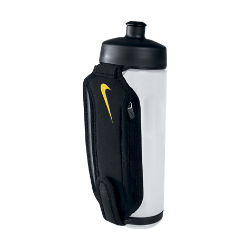Austin is known as a fit city, and in the last several years has become quite the tech city as well. These attributes may seem unrelated, but the two actually can go hand in hand.
There are so many gadgets and gizmos out there that can enhance any fitness freak’s workout. From something as simple as a good watch to distance-measuring devices complete with GPS tracking systems, everyone could benefit from a little technology.
 |
| This Boston Marathoner may look nerdy, but I bet he has some great running gadgets. From universalhub.com. |
Here are a few tools I’ve had experience with:
- Watches: It’s kind of amazing how much just a simple running watch can enhance your workout experience. Most watches have a ‘lap’ function allowing users to time their distances from different points in their workouts, making it easy to calculate pace. Inversely, if you know your approximate pace, you can explore different paths and calculate the distance, no fancy GPS system needed.
- Apple + Nike iPod Plus: I have mixed reviews about this little gadget. A USB attachment for your iPod, iPhone, or even some cardio machines syncs with a small sensor you stick in your shoe to calculate distance, elevation and pace. Unfortunately, it measures foot-to-ground strike times and not actual distance, so if you change your stride or pace at all, the distance reported can be inaccurate. It helps if you calibrate it by running a distance you know to be one mile at an average personal pace. On the bright side, a nice lady plays through your headphones and tells you when you’ve gone halfway, when you need to speed up, and congratulates you on long runs. How thoughtful.
- Heart rate monitors: The most accurate HRMs strap around your chest with heart rate sensors that sync with your watch and tell you how many calories you’ve burned based on your heart beats per minute. The more advanced models can detect cadence (or stride), speed and distance via GPS tracking. These are useful for any kind of activity, whether it’s running, cycling, a fitness class, or hiking and walking.
There are also a couple of helpful websites I’ve used for training:
This is a pretty comprehensive fitness site that offers a route-planning function, lists routes in your neighborhood others have already planned, workout and nutrition logs and ways to connect with friends and exercisers in your area. I should utilize this site more, as I tend to run the same paths over and over again out of fear of getting lost and not knowing how far I’ve run.
Myfitnesspal is a very detailed site that allows you to log everything you’ve eaten and all the exercise you’ve done in a day to calculate how many net calories you’ve consumed. It tells you how long it will take to meet a weight goal based on your daily behavior, which nutrients you need more or less of, and even how your other friends using the site are doing.
Many studies have shown that recording what you eat helps cut down on mindless snacking and overeating, so for people like me who love to work out but sometimes need guidance on nutrition, this web site is perfect. Myfitnesspal really cares about my nutrition, too; I’ve been getting a lot of e-mails reminding me to keep up with the site to meet my weight-loss goals… whoops.
Have you used any of these? Do you have some favorite fitness tools I haven't tried? Let me know!

